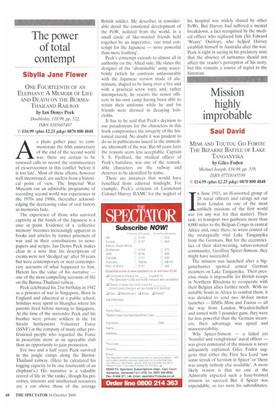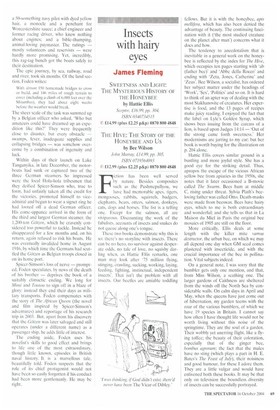Mission highly improbable
Saul David
MIMI AND TOUTOU Go FORTH: THE BIZARRE BATTLE OF LAKE TANGANYIKA by Giles Foden Michael Joseph, £16.99, pp. 319, ISBN 07718145550
£14.99 (plus /2.25 p&p) 0870 800 4848
In June 1915, an ill-assorted group of 28 naval officers and ratings set out from London on one of the most unlikely missions of the first world war (or any war for that matter). Their task: to transport two gunboats more than 8,000 miles to the Belgian Congo in central Africa and, once there, to wrest control of the strategically vital Lake Tanganyika from the Germans. But for the eccentricities of their skirt-wearing, tattoo-covered commander, Geoffrey Spicer-Simson, they might have succeeded.
The mission was launched after a biggamehunter spotted armed German steamers on Lake Tanganyika. Their presence made it impossible for British troops in Northern Rhodesia to co-operate with their Belgian allies further north. With no suitable boats in Africa to combat them, it was decided to send two 40-foot motor launches — HMSs Mimi and Toutou — all the way from London. Wooden-hulled and armed with 3-pounder guns, they were far less powerful than the German steamers; their advantage was speed and manoeuvrability.
Why Spicer-Simson — a failed yet 'boastful and vainglorious' naval officer — was given command of the mission is never adequately explained. Giles Foden suggests that either the First Sea Lord 'saw some streak of heroism in Spicer' or 'there was simply nobody else available'. A more likely reason is that no one at the Admiralty expected such a hare-brained mission to succeed. But if Spicer was expendable, so too were his subordinates: a 50-something navy pilot with dyed yellow hair, a monocle and a penchant for Worcestershire sauce; a chief engineer and former racing driver, who knew nothing about engines; and a bible-thumping, animal-loving paymaster. The ratings — mostly volunteers and reservists — were hardly more promising. Yet, incredibly, this rag-tag bunch got the boats safely to their destination.
The epic journey, by sea, railway, road and river, took six months. Of the land section, Foden writes:
With almost 150 homemade bridges to cross or build, and 146 miles of rough terrain to cover (including a climb of 6.000 feet over the Mitumbas), they had about eight weeks before the weather would break.
The sheer scale of the task was summed up by a Belgian officer who asked, Who but amateurs could have dreamed up an expedition like this?' They were frequently close to disaster, but every obstacle — swamps, fever, inadequate supplies and collapsing bridges — was somehow overcome by a combination of ingenuity and luck.
Within days of their launch on Lake Tanganyika, in late December, the motorboats had sunk or captured two of the three German steamers. So impressed were the local liola-hola tribesmen that they deified Spicer-Simson who, true to form, had unfairly taken all the credit for the victories, promoted himself to viceadmiral and begun to wear a signet ring he had looted off a dead German officer. His come-uppanee arrived in the form of the third and largest German steamer, the 1,200-ton GOtzen, which he cravenly considered too powerful to tackle. Instead he disappeared for a few months and, on his return, again refused to risk his boats. He was eventually invalided home in August 1916, by which time the Germans had scuttled the Gotzen as Belgian troops closed in on its home port.
Spicer-Simson's loss of nerve — prompted, Foden speculates, by news of the death of his brother — deprives the book of a suitably climactic ending. We long for Mimi and Toutou to sign off in a blaze of glory: instead they end their days as military transports. Foden compensates with the story of The African Queen (the novel and film inspired by Spicer-Simson's adventures) and reportage of his research trip in 2003. But, apart from his discovery that the Gt5tzen was later salvaged and still operates (under a different name) as a passenger ship, he adds little of interest.
The ending aside, Foden uses his novelist's skills to good effect and brings to life one of the most extraordinary, though little known, episodes in British naval history. It is a marvellous tale, beautifully told. Foden suspects that the role of its chief protagonist would not have been so easily forgotten if his conduct had been more gentlemanly. He may be right.











































































































 Previous page
Previous page